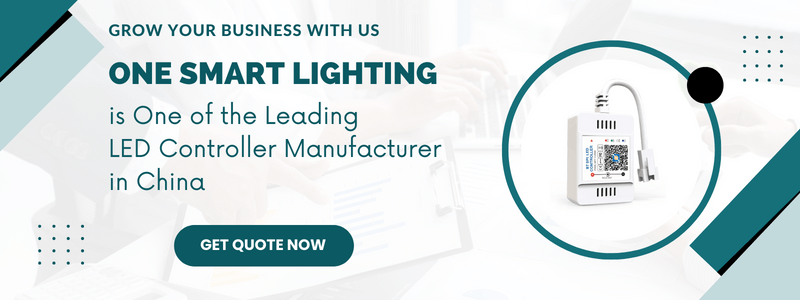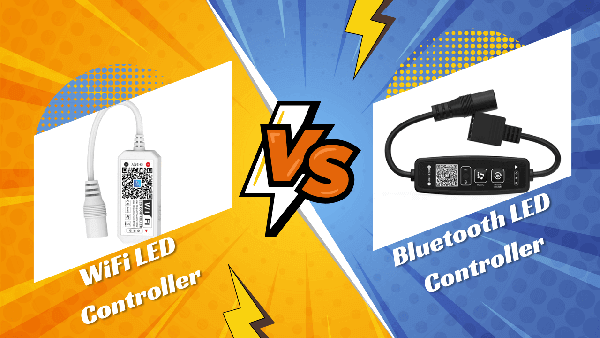LED strip controllers are electronic devices specifically designed to manage and control the operation of LED strip lights. These LED controllers allow users to customize various aspects of their LED lighting, such as color, brightness, and dynamic lighting effects, creating unique ambiances for different environments and occasions. LED strip controllers have become a popular and essential accessory for LED strip lights due to their ability to enhance the functionality and versatility of these energy-efficient lighting solutions.
LED strip lights, LED tape lights, or ribbon lights, are flexible circuit boards containing small Light Emitting Diodes (LEDs) that emit light when powered. They are available in various colors, brightness levels, and lengths, making them suitable for numerous applications, including residential lighting, commercial signage, and architectural illumination. LED strip lights are praised for their energy efficiency, long lifespan, and ease of installation.
An LED strip controller is the intermediary between the LED strip light and the power source, interpreting user input to modify the light’s output according to the desired settings. The most basic controllers only allow for simple adjustments, such as turning the lights on or off and changing the brightness level. More advanced controllers, however, offer many additional features, such as color mixing, mode selection, and even synchronization with music or other external inputs.
LED strip controllers can be operated using various methods, including infrared (IR) or radio frequency (RF) remote controls, smartphone apps via Bluetooth or Wi-Fi connectivity, and integration with home automation systems. This diverse array of control options allows users to choose the most suitable and convenient method for their specific needs and preferences.
The market for LED strip controllers has grown significantly in recent years, with numerous brands and models offering different features and capabilities. There is a wide range of options to suit various budgets and requirements. Some popular brands include Philips Hue, LIFX, Magic Home, and Govee.

Table of Contents
ToggleImportance and applications of LED strip controllers
LED light controllers play a crucial role in enhancing the functionality and adaptability of LED strips, making them indispensable accessories for various lighting applications. These controllers offer numerous benefits, including ease of use, customization, and efficient energy management, contributing to their increasing popularity in residential and commercial settings.
One of the primary advantages of LED light controllers is their ability to facilitate precise control over the lighting output. Through a user-friendly interface, users can effortlessly adjust various parameters, such as color, brightness, and dynamic effects, tailoring the lighting to their specific preferences and requirements. This level of customization allows individuals to create distinctive atmospheres and moods, transforming ordinary spaces into visually striking environments. For instance, homeowners can use LED light controllers to set up ambient lighting, accentuate architectural features, or create a cozy atmosphere for relaxation. At the same time, businesses can utilize them to design eye-catching signage, showcase products, or establish a unique brand identity.
LED light controllers also contribute to efficient energy management, enabling users to adjust the brightness level of their LED strip according to their needs. By dimming the lights when full brightness is not required, users can significantly reduce energy consumption, resulting in lower utility bills and a smaller environmental footprint. Some LED light controllers feature built-in timers and scheduling functions, allowing for automated control and enhancing energy efficiency.
Another key advantage of LED light controllers is their integration with smart home systems and the Internet of Things (IoT). Advanced LED light controllers can seamlessly connect to home automation platforms, such as Google Home, Amazon Alexa, and Apple HomeKit, enabling users to control their lighting using voice commands, smartphone Apps, or even remotely while away from home. This integration provides convenience and flexibility and allows for the creation of complex lighting scenes and routines, contributing to an enhanced user experience.
LED light controllers have applications in various settings, from residential and commercial to entertainment and architectural. In residential environments, they are commonly used for accent lighting, under-cabinet illumination, staircase lighting, and outdoor landscaping. In commercial settings, LED light controllers are vital in retail displays, advertising signage, and architectural highlighting. Additionally, they are frequently employed in event and stage lighting and in bars and restaurants, where the ability to create dynamic, customizable lighting effects is highly desirable.
Types of LED Strip Controllers
IR (Infrared) Controllers
Infrared (IR) controllers are a common type of LED light controller that utilizes infrared technology to communicate wirelessly with LED strips. These LED light controllers come with a handheld remote, which sends infrared signals to a receiver unit connected to the LED strip. The receiver then interprets the signals and adjusts the lighting parameters, such as color, brightness, and dynamic effects, per the user’s input.
IR controllers offer a cost-effective and straightforward solution for controlling LED strips. They are typically easy to install and operate, making them an attractive option for those seeking a simple yet functional lighting control system. However, there are some inherent limitations associated with infrared technology that users should be aware of when considering this type of controller.
One of the primary drawbacks of IR controllers is the requirement for a direct line of sight between the remote and the receiver unit. Infrared signals cannot penetrate solid objects or travel around corners, meaning the user must be in the same room as the LED strip and have a clear view of the receiver to control the lighting effects. This limitation can be inconvenient in certain scenarios, such as when the controller is obstructed by furniture or when the user wishes to control the lights from a different room.
RF (Radio Frequency) Controllers
Radio Frequency (RF) controllers are a popular alternative to Infrared (IR) controllers for managing LED strips. These controllers employ radio frequency technology to wirelessly transmit signals from a handheld remote or wall-mounted control panel to a receiver connected to the LED strip. By leveraging radio waves, RF controllers overcome some of the limitations of IR controllers, offering enhanced functionality and convenience.
A key advantage of RF controllers is their ability to transmit signals through walls and other solid objects, eliminating the need for a direct line of sight between the remote and the receiver. This feature allows users to control their LED strip from different rooms or outside their homes or business, providing greater flexibility and convenience compared to IR controllers. Additionally, RF controllers typically boast a longer range, often reaching 100 feet or more, making them suitable for larger spaces and commercial installations.
RF controllers are available in various configurations, with some models offering basic functions such as on/off control and brightness adjustment. In contrast, others provide advanced features, including color mixing, mode selection, and custom effects. Some RF controllers also allow multiple receivers to be paired with a single remote, enabling users to control several LED strips simultaneously or create synchronized lighting effects across different zones.
Despite their advantages, there are some potential drawbacks and considerations associated with RF controllers. Radiofrequency interference (RFI) from other electronic devices or wireless networks may occasionally cause signal disruption, affecting the controller’s performance. Moreover, RF controllers often operate on specific frequency bands, which may require users to ensure compatibility with any existing wireless systems in their environment.
Bluetooth LED Controllers
Bluetooth LED controllers represent a modern, user-friendly solution for managing LED tape lights. These LED light controllers utilize Bluetooth technology to establish a wireless connection between the LED tape light and a smartphone or tablet, providing users with a convenient and intuitive method for controlling their lighting. By leveraging the capabilities of smart devices and Bluetooth connectivity, Bluetooth LED controllers offer a range of benefits that make them an attractive option for many users.
One of the primary advantages of Bluetooth LED controllers is the ability to control LED tape lights using a dedicated smartphone app. This app-based control offers a more comprehensive and customizable user interface than traditional remote controls, enabling users to easily adjust lighting parameters, such as color, brightness, and dynamic effects. These apps often include features like color picking from photos, customizable effects, and preset lighting scenes, further enhancing the user experience.
Another benefit of Bluetooth LED controllers is the potential for seamless integration with other smart home devices and platforms. Many Bluetooth LED controllers are compatible with popular home automation systems, such as Google Home, Amazon Alexa, or Apple HomeKit, allowing users to incorporate their LED tape lights into their existing smart home ecosystem. This integration enables voice control, remote access, and the creation of complex lighting routines, contributing to a more connected and efficient living environment.
Despite their advantages, some considerations exist when opting for a Bluetooth LED controller. Most notably, Bluetooth controllers have a limited range, typically around 30 to 50 feet, which may be insufficient for larger installations or controlling lights from a significant distance.
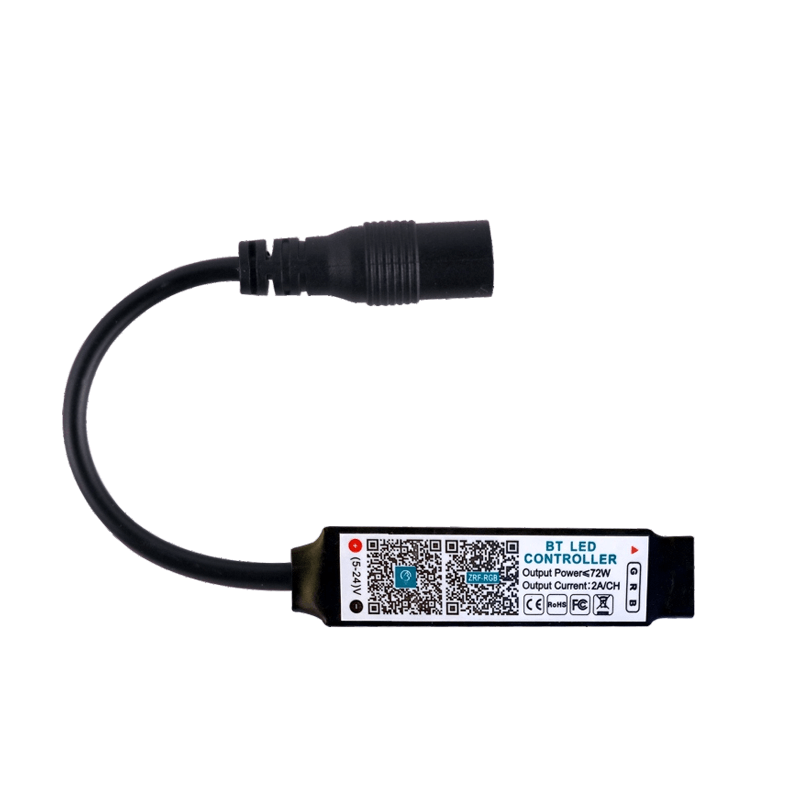
Wi-Fi LED Controllers
Wi-Fi LED controllers are advanced devices designed to control LED ribbon lights using Wi-Fi technology. These LED controllers connect to a home or business Wi-Fi network, enabling users to use a smartphone, tablet, or computer to manage their LED lighting. By harnessing the power of Wi-Fi connectivity and smart device capabilities, Wi-Fi LED controllers offer a wealth of benefits that make them an appealing choice for those seeking a versatile and feature-rich lighting control solution.
One of the key advantages of Wi-Fi LED controllers is the ability to control LED ribbon lights remotely from virtually anywhere with an internet connection. This remote access allows users to adjust their lighting settings, such as color, brightness, and dynamic effects, even when away from home or their business, providing unparalleled convenience and flexibility. This feature can also enhance security by giving the impression of occupancy when users are on vacation or away for an extended period.
Another significant benefit of Wi-Fi LED controllers is their compatibility with popular smart home platforms, such as Google Home, Amazon Alexa, and Apple HomeKit. This integration enables users to control their LED ribbon lights using voice commands, create complex lighting routines, and synchronize them with other smart devices in their homes or business. Users can achieve a more connected and efficient living or working environment by incorporating LED ribbon lights into a smart home ecosystem.
Wi-Fi LED controllers often come with dedicated smartphone apps that offer a comprehensive and customizable user interface. These apps provide a wide array of features, such as color picking, customizable effects, and preset lighting scenes, which enable users to tailor their lighting experience to their specific preferences and requirements.
Despite their numerous advantages, Wi-Fi LED controllers may have some drawbacks. They can be more expensive than other controllers, such as IR or RF controllers, and may require a stable Wi-Fi connection for optimal performance. Additionally, network security should be considered, as the controller connects to the user’s Wi-Fi network, potentially exposing it to security vulnerabilities if not properly secured.
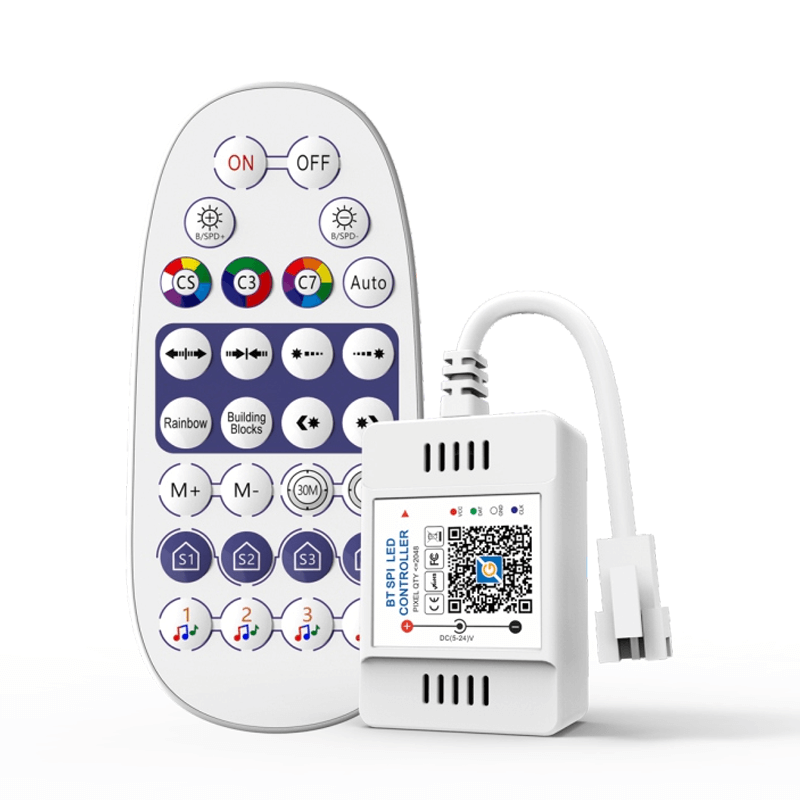
DMX LED Controllers
DMX LED controllers are advanced lighting control devices that utilize the DMX512 protocol, an industry-standard communication system widely used in professional stage, event, and architectural lighting applications. These controllers offer precise and sophisticated control over LED ribbon lights, making them an ideal choice for users seeking high customization and programmability in their lighting setups.
One of the main advantages of DMX LED controllers is their capacity to simultaneously control many LED ribbon lights or other DMX-compatible lighting fixtures. Each DMX512 network can support up to 512 individual channels, allowing for complex, synchronized lighting effects across multiple lights or zones. This scalability makes DMX controllers well-suited for large installations, such as concert stages, theaters, and architectural projects.
Furthermore, DMX LED controllers provide high precision and customization, enabling users to create intricate lighting scenes and dynamic effects that are difficult to achieve with other types of controllers. Many DMX LED controllers come with dedicated software or hardware interfaces, allowing users to program and adjust lighting parameters with exceptional accuracy, such as color, intensity, and timing.
DMX LED controllers have some limitations. They can be more complex and challenging to set up and operate compared to other types of controllers, such as IR, RF, or Bluetooth controllers. Additionally, DMX LED controllers are often more expensive, reflecting their advanced features and professional-grade performance.
Key Features and Functions of LED Strip Controllers
Wireless LED controllers allow users to manipulate various aspects of their LED lights strip, allowing for a highly customizable and dynamic lighting experience. These controllers come in different types, such as IR, RF, Bluetooth, Wi-Fi, and DMX, each offering distinct advantages and limitations. Regardless of the type, most Wireless LED controllers share some common features and functions outlined below.
Color Control
Color control is one of the most basic and essential functions of an RGB LED controller. This feature allows users to adjust the color of their RGB LED strip lights, typically by mixing different intensities of red, green, and blue (RGB) or even adding white (RGBW) for a broader color palette. Some controllers offer a color wheel or color picker interface, allowing users to choose various colors easily. This functionality is useful for creating specific moods or themes and matching the lighting to the surrounding décor.
Brightness Control
Brightness control is another fundamental feature provided by RGB LED controllers. This function allows users to adjust the intensity of their LED light strip, ensuring that the lighting is suitable for various activities and conditions. For instance, users may prefer lower brightness levels for a relaxed ambiance or movie night and higher brightness levels for tasks that require focused attention, such as reading or working.
Modes and Effects
RGB LED controllers offer a variety of modes and effects, allowing users to create dynamic and engaging lighting experiences. These modes and effects range from simple static color displays to complex, synchronized patterns.
Static Color Modes
Static color modes enable users to select a single color for their LED string lights. This feature is useful for creating a consistent and uniform lighting environment or emphasizing a specific color theme.
Dynamic Modes
Dynamic modes involve changing colors, patterns, or brightness levels over time. These modes can include pre-programmed effects, such as color fades, strobes, or chases, which can be customized by adjusting parameters like speed and color sequence.
Music Syncing
Some RGB LED controllers have a built-in microphone or audio input, allowing the lights to sync with music or ambient sounds. This feature creates a dynamic and immersive atmosphere, making it popular for parties, events, or home entertainment setups.
Custom Effects
Advanced RGB LED controllers may offer the ability to create and save custom effects, giving users even greater control over their lighting experience. Custom effects can range from personalized color sequences and transitions to intricate, multi-zone lighting patterns.
Timers and Scheduling
Timers and scheduling are valuable features that allow users to automate their LED string lights according to specific times, days, or events. This functionality can help conserve energy, enhance security, and promote a more comfortable and efficient living or working environment. For instance, users can program their LED string lights to turn on or off at predetermined times, gradually increase brightness in the morning, or automatically switch to a specific mode when they return home.
Compatibility and Connectivity
When selecting a wireless LED controller, it is crucial to consider compatibility and connectivity factors to ensure your LED strip lights’ seamless and efficient operation. These aspects include the type of LED strip you use, voltage requirements, methods for connecting multiple LED strips, and integration with smart home systems.
LED Strip Types and Voltage Requirements
LED strips come in various types, such as single-color, color-changing (RGB or RGBW), and addressable strips. Each type of LED strip requires a specific controller to manage its unique features and functionalities. For example, a single-color LED strip controller will not work with an RGB LED strip, as it cannot control individual color channels. Therefore, it is essential to choose a controller compatible with the type of LED strip you plan to use.
LED strips operate at different voltage levels, typically 12V or 24V. The voltage requirement of your LED strip must be considered when selecting a controller, as mismatches in voltage can result in poor performance or even damage to your LED strip lights. Ensure your chosen controller is designed to handle the correct voltage level for your LED strip lights.
Connecting Multiple LED Strips
In many installations, connecting multiple LED strips to create a cohesive lighting design may be necessary. When using a single wireless LED controller to manage multiple LED strips, you must consider factors such as the controller’s maximum load capacity and the method of connecting the LED strips.
To determine the maximum load capacity of a controller, check the manufacturer’s specifications for the maximum number of LED strip lights or total wattage it can support. Exceeding this limit can result in poor performance, overheating, or damage to the controller and LED strips.
There are several methods for connecting multiple LED strips to a single wireless LED controller
Parallel Connection: This method directly connects all LED tape lights to the controller’s output terminals. Parallel connections allow for consistent voltage and brightness across all LED strips but may require a controller with a higher load capacity.
Series Connection: In a series connection, LED strips are connected end-to-end, with the output of one strip feeding into the input of the next. This method may lead to voltage drop and reduced brightness in longer runs, necessitating the use of additional power supplies or amplifiers.
Signal Amplifiers: Signal amplifiers can be used to extend the range and capacity of a controller by boosting the signal and providing additional power to the LED strips. Amplifiers are particularly useful in large installations or when connecting multiple LED strips with high power requirements.
Integration with Smart Home Systems
Modern wireless LED controllers often come with capabilities for integration with popular smart home systems, such as Google Home, Amazon Alexa, or Apple HomeKit. This integration allows users to control their LED strip lights using voice commands, create complex lighting routines, and synchronize them with other smart devices in their homes or business.
When selecting a wireless LED controller with smart home integration, ensure it is compatible with your existing smart home platform and supports the specific features you require, such as voice control or remote access. Additionally, consider any potential security implications, as connecting your wireless LED controller to a smart home system may expose it to vulnerabilities if not properly secured.
Installation and Setup
The installation and setup process for an LED strip controller is an essential aspect to consider, as it can impact your LED strip lighting system’s overall performance and user experience. You can ensure a smooth and successful installation by following the proper steps and guidelines. This section covers important considerations, such as choosing the right controller, power supply requirements, controller placement and mounting, connecting the controller to the LED strip, and configuring the controller via a smartphone app or remote control.
Choosing the Right RGB LED Controller for Your RGB LED Strip
Before installing an RGB LED Controller, selecting a controller compatible with your RGB LED strip type, voltage requirements, and desired features is crucial. Consider the following factors when choosing a controller:
LED Strip Type: Ensure the controller is compatible with your specific LED strip (e.g., single-color, RGB, RGBW, or addressable).
Voltage Requirements: Verify that the controller supports the voltage level of your LED strip (typically 12V or 24V).
Connectivity: Determine the type of controller that best suits your needs, such as IR, RF, Bluetooth, Wi-Fi, or DMX, based on factors like range, ease of use, and compatibility with smart home systems.
Features and Functions: Evaluate the available features and functions, such as color control, brightness control, modes and effects, timers, and scheduling, to ensure the controller meets your specific requirements.
Power Supply Considerations
A suitable power supply is necessary to operate your 12V LED strip controller properly and RGB LED strip lights. When choosing a power supply, consider the following:
Voltage: Ensure the power supply provides the correct voltage for your LED strip (12V or 24V).
Wattage: Calculate the total wattage of your LED strip(s) and choose a power supply with a wattage rating of at least 20% higher to account for potential power fluctuations and avoid overloading.
Safety and Certification: Select a power supply with safety features, such as short circuit, overload, and over-temperature protection, and ensure it has the necessary certifications, such as UL or CE.
Controller Placement and Mounting
The placement and mounting of your 12V LED strip controller are important for ease of access, signal strength, and aesthetics. Consider the following when choosing a location for your controller:
Accessibility: Place the controller in an easily accessible location for configuration and control.
Signal Range: For controllers that rely on wireless communication (e.g., IR, RF, or Bluetooth), ensure the controller is within the necessary range of the remote control or smartphone.
Aesthetics: Conceal the controller and wiring when possible to maintain a clean and professional appearance.
Connecting the 12V LED Controller to the 12V LED Strip
Follow the manufacturer’s instructions for connecting your 12V LED Controller to the 12V LED strip and power supply. This process typically involves connecting the power supply to the controller’s input terminals and the LED strip to the controller’s output terminals. Ensure proper polarity and secure connections to avoid potential issues or damage.
Configuring the Controller via Smartphone App or Remote Control
Once the 12V LED light controller is connected and powered, configure the controller using the provided smartphone app or remote control. This process may include:
- Connecting the controller to your Wi-Fi network (for Wi-Fi controllers)
- Pairing the 12V LED light controller with your smartphone or remote control
- Configuring settings, such as color, brightness, modes, and effects
- Setting up timers and schedules
- Integrating the controller with your smart home system, if applicable
Comparison of popular brands
LED strip controllers are essential for managing and customizing the color, brightness, and effects of LED tape lights. Several popular brands offer high-quality controllers with different features and compatibility options. Some top brands include Philips Hue, LIFX, Magic Home, and Tuya Smart.
Key features and pricing
Philips Hue Smart LED Controller
Features: Philips Hue offers a variety of LED strip controllers, including the Hue Light strip Plus, which is compatible with Hue Bridge, allowing for comprehensive control over color, brightness, and effects. Philips Hue controllers also support voice control via Amazon Alexa, Google Assistant, and Apple HomeKit.
Pricing: The Philips Hue Light strip Plus controller, excluding the LED strip, costs around $60.
LIFX Z Wi-Fi LED Controller
Features: LIFX Z is a Wi-Fi-enabled WiFi LED controller that doesn’t require a hub. It supports 16 million colors, customizable zones, and effects like color cycling, music visualization, and more. LIFX Z is compatible with popular voice assistants like Amazon Alexa, Google Assistant, and Apple HomeKit.
Pricing: The LIFX Z LED strip controller is priced at around $90, which includes a 2-meter LED strip.
Magic Home Pro LED Controller
Features: Magic Home Pro is a budget-friendly option that uses Wi-Fi for control and supports 16 million colors, timers, and customized scenes. It also integrates with popular voice assistants like Amazon Alexa and Google Assistant. Magic Home Pro is compatible with both single-color and RGB LED strips.
Pricing: The Magic Home Pro LED strip controller typically costs around $15 to $20.
Tuya Smart LED Controller
Features: Tuya Smart is another Wi-Fi-enabled LED controller compatible with single-color and RGB LED strips. It features 16 million colors, dimming, and scheduling options and works with popular voice assistants like Amazon Alexa and Google Assistant.
Pricing: The Tuya Smart LED strip controller is priced around $10 to $20.
Pros and cons of each model
Philips Hue Smart LED Controller
Pros: Offers seamless integration with the Philips Hue ecosystem, high-quality color reproduction, and compatibility with multiple voice assistants.
Cons: Requires a Hue Bridge for full functionality, which increases the overall cost.
LIFX Z Wi-Fi LED Controller
Pros: No hub required, customizable zones for unique effects, and compatibility with various voice assistants.
Cons: Higher price points compared to other options, and some users may experience connectivity issues.
Magic Home Pro LED Controller
Pros: Affordable option with a wide range of features, compatibility with various voice assistants, and support for single-color and RGB LED strips.
Cons: The build quality may not be as high as other options, and some users report occasional connectivity issues.
Tuya Smart LED Controller
Pros: Budget-friendly, easy setup, and compatible with popular voice assistants.
Cons: Not as feature-rich as other options, and potential connectivity issues.
Tips for Using LED Strip Controllers
LED strip controllers allow users to customize the color, brightness, and effects of LED strip lights, creating unique lighting experiences. To get the most out of your LED strip controller, following safety guidelines, maximizing performance, and troubleshooting common issues are essential.
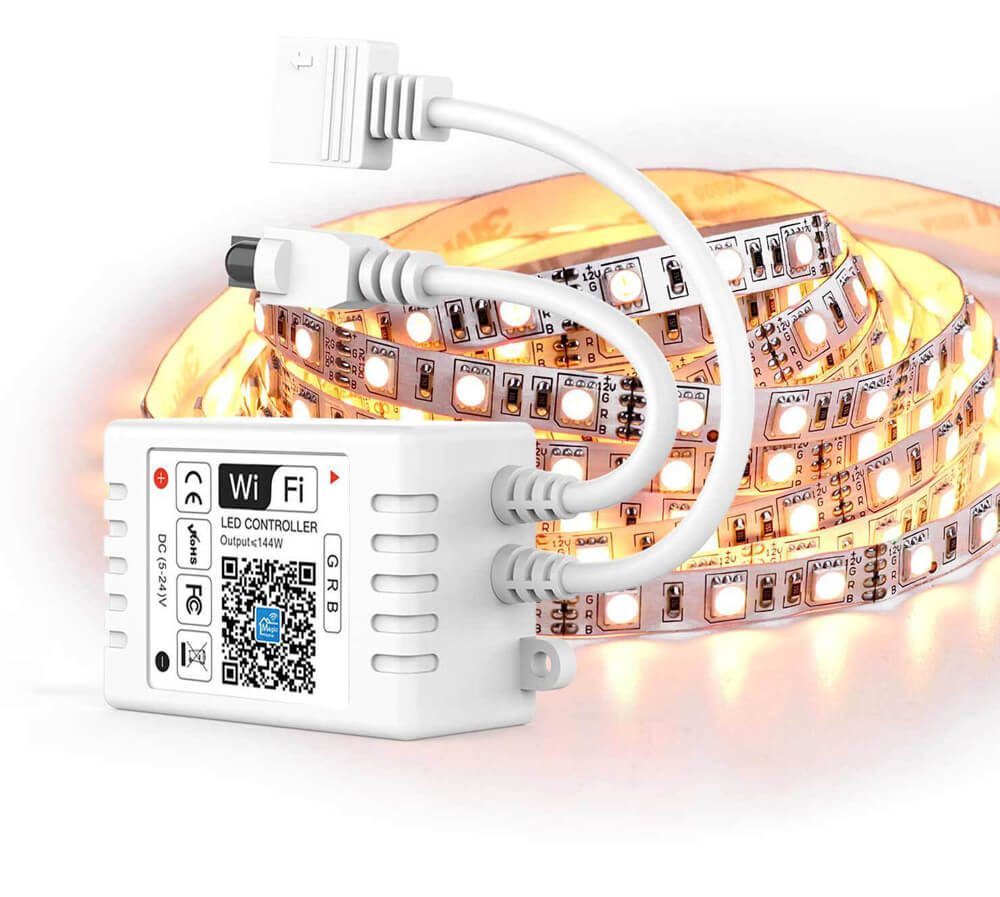
Safety tips and considerations
Choose the right LED controller: Ensure that the controller you select is compatible with your LED strip in terms of voltage, wattage, and type (single-color, RGB, or RGBW). Using the wrong controller can result in poor performance or even damage to the LED strip or LED dimmer.
Avoid overloading: Overloading the LED dimmer by connecting too many LED strips can cause it to overheat, reducing lifespan or damage. Always check the controller’s maximum load capacity and ensure your LED strip setup does not exceed this limit.
Inspect power supply: A stable and appropriate power supply is crucial for the safe operation of your LED dimmer. Ensure the power supply has the correct voltage and wattage rating for your LED strip and controller setup.
Proper installation: Follow the manufacturer’s instructions for installation to prevent electrical shorts or damage. Ensure all connections are secure and that the controller is mounted in a well-ventilated area to avoid overheating.
Keep away from water and moisture: Most LED strip controllers are not waterproof or moisture-resistant. Install the controller in a dry, protected location to prevent short-circuiting or damage.
Maximizing LED controller performance
Update firmware: Manufacturers often release firmware updates to improve performance, fix bugs, or add new features. Regularly check for and install updates to ensure your controller operates at peak performance.
Optimal Wi-Fi signal: For Wi-Fi-enabled controllers, ensure the controller is within range of your Wi-Fi router for a stable connection. Wi-Fi extenders can help improve signal strength in areas with weak coverage.
Grouping and zoning: Group similar LED strips or create zones to simplify control and coordinate lighting effects. It allows you to change colors, brightness, or effects for specific areas without affecting the entire setup.
Explore app features: Many Smart LED controllers come with companion LED controller apps that offer advanced features like color palettes, custom scenes, or integration with other smart home devices. Spend some time exploring these features to unlock the full potential of your controller.
Use voice assistants: LED strip controllers compatible with Amazon Alexa, Google Assistant, or Apple HomeKit can be controlled using voice commands. Set up voice control for hands-free operation and convenience.
Troubleshooting common issues
Connectivity issues: If your controller struggles to connect to Wi-Fi, try moving it closer to your router, rebooting your router, or resetting the controller to factory settings. Ensure your Wi-Fi network is working correctly and the controller is compatible with your network frequency (2.4 GHz or 5 GHz).
Unresponsive LED strip: If the LED strip is not responding to the controller, check all connections and ensure the strip and controller are compatible. Inspect the power supply for any issues and verify that the controller functions correctly.
Limited functionality: If your RGBW LED controller is not providing the expected range of colors or effects, ensure you are using the appropriate LED strip type (RGB or RGBW) and that the controller supports the desired functionality. Update the firmware if necessary.
Flickering or inconsistent colors: Check the power supply and controller for compatibility issues if the LED strip flickers or displays inconsistent colors. Inspect the connections between the controller and the LED strip, ensuring a secure and stable connection.
Conclusion
Summary of key points
LED strip controllers play a pivotal role in customizing and managing LED strip lights, enabling users to create unique lighting experiences tailored to their preferences. Several popular brands offer high-quality controllers with distinct features, compatibility options, and price points. Philips Hue, LIFX, Magic Home, and Tuya Smart are among the top brands offering a range of controllers to suit various needs.
To ensure safety and optimize performance, selecting the appropriate controller, avoiding overloading, ensuring a stable power supply, and following proper installation guidelines are crucial. Enhancing controller performance can be achieved by updating firmware, optimizing Wi-Fi signals, grouping and zoning, exploring app features, and utilizing voice assistants. Troubleshooting common issues involves addressing the connectivity, unresponsive LED strips, limited functionality, and flickering or inconsistent colors.
Future trends and developments in LED strip controllers
As technology evolves, several trends and developments in LED strip controllers will likely emerge, further enhancing their capabilities and user experience.
Increased integration with smart home ecosystems: LED strip controllers are expected to offer more seamless integration with various smart home systems, allowing users to control their lighting alongside other devices such as thermostats, security systems, and home entertainment.
Improved energy efficiency and sustainability: Future LED strip controllers may emphasize energy efficiency with features such as adaptive brightness, motion sensors, and energy usage monitoring, contributing to more sustainable lighting solutions.
Enhanced customization and personalization: As demand for unique lighting experiences grows, LED strip controllers may offer more advanced customization options, including finer control over color gradients, animated lighting effects, and integration with music, movies, or games.
Machine learning and AI-driven features: Incorporating machine learning and artificial intelligence into LED strip controllers could lead to more intuitive and intelligent lighting controls. These features could enable the controllers to learn users’ preferences, adapt to their habits, and anticipate their needs.
Greater accessibility and inclusivity: Future LED strip controllers may focus on making lighting control more accessible to users with disabilities or varying levels of technological proficiency. It could include voice-command improvements, more intuitive app interfaces, and alternative control methods.
Final thoughts on the importance of LED strip controllers
LED strip controllers are an essential component of LED strip lighting systems, allowing users to create tailored lighting environments that enhance their spaces and suit their individual needs. They offer versatility, creativity, and convenience, transforming ordinary spaces into vibrant, dynamic, and engaging environments.
As technology advances, LED strip controllers are expected to evolve, offering even more customization options, improved energy efficiency, and seamless integration with smart home ecosystems. By staying informed about the latest developments and trends, users can make the most of these innovative lighting solutions, creating unique and personalized experiences that elevate their surroundings.
LED strip controllers offer a world of possibilities, empowering users to harness the full potential of LED strip lights. By carefully selecting the right controller, following safety guidelines, maximizing performance, and troubleshooting common issues, individuals can create captivating lighting atmospheres and enjoy the many benefits LED strip lights offer.
Related Articles

